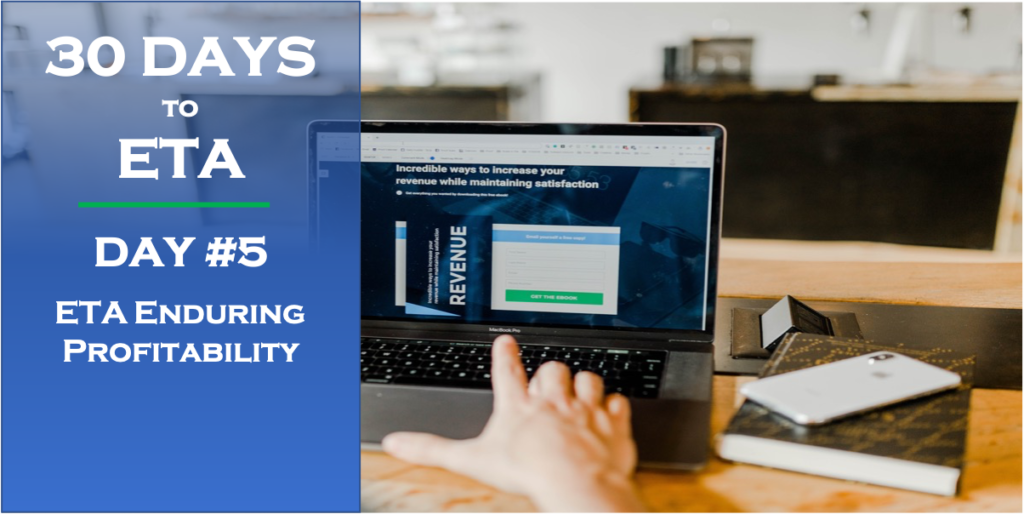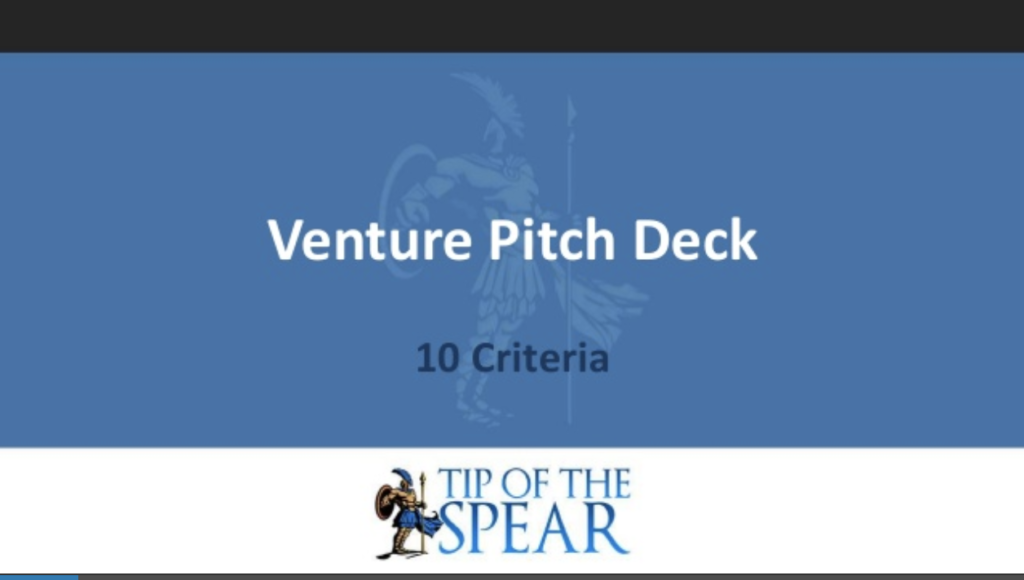If you’ve been reading this 30 Days to ETA blog series, you’ve learned that having a business plan is essential for end results for success and that you should have that “end state” mentality in mind as you look to acquire a business. We’ve also explored your ETA Competitive Advantage that should allow you to be strategic in your direction and tactful in your actions to execute that business plan (You can read the previous post by CLICKING HERE). But there’s a key organizational attribute that you should screen for while conducting your Entrepreneurship Through Acquisition (ETA) process, that being Enduring Profitability. So in this 30 Days to ETA post, we’ll explore the concept of Enduring Profitability and how it should form the cornerstone of your search criteria… Enjoy!
Attend Webinar Workshop: 30 Days to ETA
What is Enduring Profitability?
If you’re like me and most entrepreneurs around the country, you work incredibly long hours. Entrepreneurs Through Acquisition spend much of their personal time working in their business, and rarely take vacations. It’s not something they have “time” to do. But why are they killing themselves by working so much? Didn’t they go into business to have more free time? If so, why can’t they take breaks without feeling guilty? It’s like the harder they work, the better off they’d be. I would argue that part of this “workaholic” state is induced by the pursuit of Enduring Profitability. I would define Enduring Profitability as the consistent achievement of profitability by the organization. Year after year, regardless of pandemic or economic situation, the organization can show on their financial statements the achievement of profitability.
Unfortunately, hard work isn’t the key to success. Without a doubt, we have to work hard to be successful. You’re definitely not going to reach success without some sweat equity, but there’s something more important. To make your business successful enough for your end-game results (i.e., to sell it), your hard work must go into making your business scalable in nature. There is no better reflection of the hard-work you put in and the scalable nature than Enduring Profitability.
What does scalable mean? Simply put, scalability is the ability to grow your business. Growing your business doesn’t necessarily mean making it into a franchise and opening store fronts all over the nation or the world. How many companies actually do that? That’s not necessarily our goal.
Business growth in scalability revolves around revenue and profits. In other words, how can we increase revenue and decrease costs involved to produce that revenue? Essentially, how do we make profits high and costs low; how do we increase our margins? Remember, people buy businesses that make money, and scalable businesses that show enduringly profitable characteristics typically bring larger price tags.
To use a baseball analogy, it’s the consistent singles and doubles that win the business game. Rarely is it the attempt to hit a home run that results in success for Entrepreneur Through Acquisition (ETA).
Sam Palazzolo, Managing Director @ Tip of the Spear Ventures
The Building Blocks of Scalability and Enduring Profitability
Maybe your business is already making money. Perhaps your business is booming with good employees and exponential sales’ growth. Sure, but I’m assuming that you’re not content with where you are; you want to make even more money and experience more growth. There’s no better time than now to invest your time, energy and passion into developing foundational systems that will help your business reach long-term success.
Just like a house, your business has to have a sound foundation. From our previous post, you know that foundation is your business plan. But the building blocks of the foundation – the footer, the piers, the concrete, the rebar – are what make your business scalable. The following three aspects make a business scalable: Strong Management Systems, Scalable Product Solutions, and Strategic Thinking.
Building Blocks to Build a Scaleable Business
1. Management Systems
Deep-rooted systems help us maximize our business growth so that we can make as much money as possible while minimizing growing pains. So when the storms of employee issues rush in or the gales of family issues flood our business world, we’ll have systems built to withstand the storms. These systems usually come in the form of processes surrounding people and technology. Here is a list of seven technology systems I’ve used in my own companies that have dramatically increased their scalability:
- Customer Relationship Management System, a.k.a. CRM System – In order to get customers and to keep them in your business, you should put a system in place that analyzes and manages your interactions with customers. This software, or this team, will collect data about your customers that includes their demographic information, what brought them to your business, what they’re buying from you, and how often they use you. The data alone doesn’t do anything for your business. You must have a team or a software program that can analyze the data with the goal of improving business relationships with customers, retaining customers, and up-selling to customers.
- Financial Management System – You also need a system to track where your money’s coming from and where it’s going. Basically, this is your record keeping system for income and expenses. Some financial management systems have sister CRM systems that link and sync information. Other financial management software systems have CRM components built into their basic structure so that business owners can use one program to accomplish two tasks.
- Sales Management System – In this third system, you’re going to need a team who knows how to use the data you collected from your CRM system to make potential customers actual customers. This system funnels clients from the wide “prospective client” mouth of the funnel to the narrow “actual client” part of the funnel to make the sale.
- Legal Management System – Ultimately, your business may delegate the operations of this system to a law firm as you grow. But initially, you’ll need a computer program or a paper filing system in place to store your business agreements, contracts, correspondence, identifying information, tax records, and employment records. However, you can’t just use the system for storage. You must have a team in place who can stay up-to-date and compliant with ongoing legal changes on local, state, and federal levels.
- Marketing Management System – Systems one through four focus on your current customers and financials, but this fifth system helps you reach new consumers. Once you review the demographics of your target market from your CRM, you can plan what type of media you need to use to reach the customer. Should you offer your products and services through social media, print advertising, radio announcements, or TV commercials? Have a program or team in place that can strategically get your product in front of your ideal customer.
- Talent Management System – Usually called “Employee Management Systems,” this system is how you find, hire, manage, and retain talented people. Without a good team in place, you won’t be able to reach your business goals. Moreover, have eyes on your talent four years out. Don’t look for good people on the spur of the moment; recruit on-going, consistently, purposefully and methodically.
- Operational Management System – Finally and most importantly, your operational system manages all the other systems. It’s the written documentation of how your company runs. Whether it’s as basic as a hand-written bubble graph on a yellow legal pad or as complicated as a programmed and editable flow chart, this outline details the systems you’ve put into place, who manages them, how they function, and the benefit they provide your company. This operational system is the way you can manage the company without being physically in the company.
2. Product Solutions
In the early days of business, money is often tight, and it seems like business owners constantly have less than we need (I’ve mentioned previously the importance of cash flow management). In addition, our time and expertise are in constant demand. Implementing systems will take you time and money, but this second building block will increase your business’s scalability without a lot of time or money. What I’m talking about is just taking a moment and identifying the things in your business that can be easily increased or reduced to maximize your business’s profitability and revenue.
So here are seven questions you can ask yourself as you screen for a business to acquire:
- What product/service do you offer that has the highest margins?
- Which product/service has the potential to reach double-digit growth rates?
- What product/service can the team easily explain to the marketplace?
- Which product/service can secure outside leverage?
- Is there a product/service easy to market?
- What product/service can be automated?
- Can a product/service be franchised, licensed, or duplicated?
Your answers to the questions will show you how to take a product or service offering and scale it up. In other words, what you learn about the prospective business’ products/services will help you identify opportunities to increase revenue and decrease costs. You now have potential scalable business solutions.
3. Mind Shift Toward Scalability
The third aspect you have to do to make a scalable business is change your way of thinking. You’ve got to learn to think strategically. If you don’t know where you’re going, you won’t know what road to take to get there. If you’ve gotten this far in 30 Days to ETA series, you should have identified your exact business goals and written them down into a business plan. You should now be looking at ways to make prospective businesses you’re looking to acquire more valuable than the competition.
In order to build a plan for scalability, you must take the focus off of yourself in the business. For the company to be attractive, it can’t be wholly dependent on you. You wouldn’t even be where you are in business if it weren’t for people around you. Take a step back to understand that you are building a business that can operate without you. Therefore, you AND the future team must be successful together.
So how do you change your thinking?
- Let go of “This is Me” thinking. – You must turn the conversation of your business from “I” to “We.” Stop thinking, “I’m the business owner who started this.” Instead, start thinking, “We have an outstanding business.” Turn from “My” to “Our.” Go from “This is My” to “This is Our.” It’s a play on words you see, but it has such intrinsic meaning.
- Be the coach, not the star. – You didn’t become successful alone. Somewhere along the way, someone invested in your life. Maybe it was a family member, a friend, a pastor, a teacher, or a coach. Or maybe you read an inspirational book or blog post that changed your life’s direction. Inevitably, somebody in your life has dedicated or sacrificed time, money, and energy to help you. It’s time for you to do that now. If you’re going to build a scalable business, you have to be the coach. You have to cheer your team on to the victory.
- Build the right team. – If you’re going to coach people to take over the everyday parts of your business, you have to hire the right people. Don’t look for “cheap talent.” If you get people who are less than your best, you’re going to get less than your best results. Hire the best people you can afford because great people yield great results.
- Get help. – Sure, you can run the company by yourself. For the most part, you know what you’re doing. But you’re still going to need somebody in your corner. You’re going to need encouragement and financial advice. You’ll need an objective person to point out your failures and motivate you to success. Whether it’s a professional like a CPA or CFP, a family member or friend, or a board of advisers, you’re going to need help for yourself.
- Remember your family. – If you’re like most entrepreneurs, then you spend a lot of time building your business to the detriment of your family. You have to make time spent away from your family the exception, not the habit. If you’re going to build a scalable business, you’re going to have to walk away once you have all of your systems in place. If you’ve become a stranger to your family and friends, what will you do? Who will be left with you when you reach success and have time to enjoy life?
SUMMARY
Remember, the goal we’re dealing with first and foremost in this particular series is acquire a business in 30 days with the goal of ultimately selling it. If we’re going to sell our company for top dollar, then the business has to be scalable and reflect enduring profitability. We have to increase revenue and decrease the costs it takes to produce that revenue to attract buyers and to get the most money possible from the buyers. Are you prepared to buy then build a scalable business? Read on in the series (We’re early, right… It’s only Day 5 on the way to Day 30!)
Sam Palazzolo




